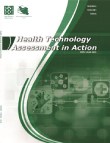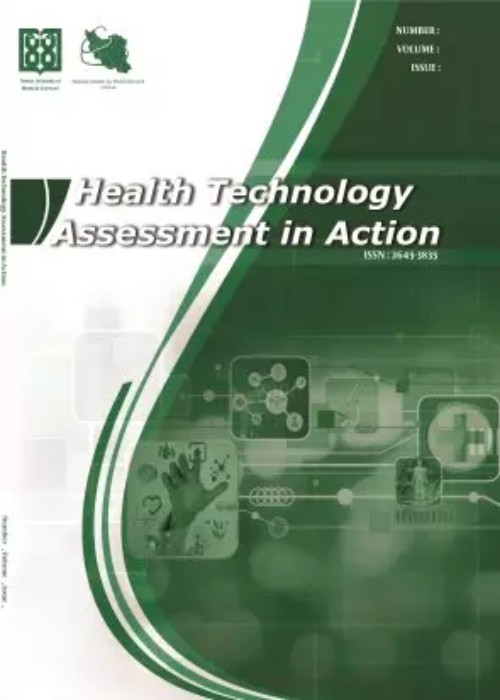فهرست مطالب

Health Technology Assessment in Action
Volume:6 Issue: 3, Jun 2022
- تاریخ انتشار: 1401/09/30
- تعداد عناوین: 6
-
-
Page 1Background
The success of the supply chain can be summed up in the satisfaction level of business partners and customers, according to several diverse needs of each of the business partners in the studied supply chain, including the country’s pharmaceutical industry and suppliers of raw materials.
MethodsThis study has attempted to investigate satisfaction according to the views under possible scenarios to improve satisfaction. The model presented in this regard to realize the main objective of this study is based on the principles of system dynamics, and VENSIM DSS has been used for its design.
Resultsaccording to the study results, it can be acknowledged that the satisfaction of each of the business partners with the supply chain is different from each other, and the best scenarios to improve the satisfaction include an improvement of 3% in inventory management and a reduction by 5% in rework and parallel work during the studied period.
ConclusionsUnder this scenario, the satisfaction of business partners in this regard will improve during the studied period, or in other words, the satisfaction of the parties will move optimally.
Keywords: Supply Chain, Satisfaction, System Dynamics -
Page 2
Groundbreaking knowledge at the nanoscale has been developed in many functional and industrial situations. Nanoscale colour recognition sensors have been developed by researchers in order to offer new ways to identify harmful germs. This study objective was to evaluate the ability of nano-biosensors colour indicators to identify nosocomial infection reservoirs.
MethodThe enquiry was conducted in a semi-experimental environment for a month. Samples were obtained both prior to and during standard disinfection. The final findings were described as both clean and infected. There were 400 cases in the sample, 10 different types of equipment were employed, and sampling was done.
ResultsThe results showed high contamination of the studied surfaces. Moreover, 55% of the samples were infected before disinfection, which was reduced to 36.5% after routine disinfection.
ConclusionThe findings show that this tool has the necessary sensitivity, and we can introduce it as a standard tool for microbial contamination in the future; however, the aim was not to identify the type of microorganism.
Keywords: Infection Control, Nanotechnology, Indicators, Reagents, Healthcare Associated Infections, Cross Infection -
Page 3Background
Effective education for learning in professional fields, especially dentistry, is one of the necessities of society, and considering the importance of oral and maxillofacial diseases in dentistry as well as the lack of information in the field of comparing modern teaching methods and traditional methods.
ObjectivesThis study was conducted to compare the effect of two methods of face-to-face education, lecture, and virtual education, on the motivation and academic progress of 6th-semester dental students.
MethodsIn this randomized intervention study, 36 students in the 6th semester of dentistry in Birjand were randomly divided into two intervention and control groups. In the control group, the face-to-face teaching method was used in lecture style, and in the second group, the online virtual teaching method was used. Before and after the intervention, the same written test of educational content was taken from both groups, and academic motivation was measured with the Academic Motivation Scale (AMS) of Vallerand et al. The data were analyzed with SPSS software and using descriptive statistics, independent t-tests, and paired t-tests. The P-value was considered significant at the level of 0.05.
ResultsThe average age of the participants in the face-to-face training group was 23.89 ± 2.826, and in the virtual group was 23.50 ± 1.855, which was not statistically significant (P = 0.629). There was no significant difference between the average scores of students’ motivation and academic progress between the two groups before (P > 0.05) and after the intervention (P > 0.05). Although there was an increase in students’ average scores of academic motivation and academic progress after the intervention between the two groups of face-to-face education and virtual education, there was no statistically significant (P > 0.05).
ConclusionsIt seems that virtual teaching, like lecture teaching, can be effective in students’ academic progress and motivation and can be considered a complementary teaching method.
Keywords: Traditional Education, Virtual Education, Academic Motivation, Academic Progress -
Page 4Background
In this research, the effectiveness of group cognitive behavioral therapy on depression, cognitive flexibility, and cognitive regulation of emotion in women with breast cancer was discussed.
MethodsThis research was a quasi-experimental study with two experimental and control groups, conducted on 30 women with breast cancer in Tehran who participated in the study willingly and knowingly. The subjects were divided into two groups based on random sampling. This research used Beck Depression Questionnaire, Dennis and Vander Wal Cognitive Flexibility Questionnaire, Garnefski, Kraaij and Spinhoven Cognitive Emotion Regulation Questionnaire, and the Leahy group cognitive behavioral protocol. The treatment protocol was conducted during eight 90-minute sessions. Finally, a post-test was taken from both groups two months later. The collected data was entered into the SPSS-20 program and analyzed with covariance statistical tests and a significance level of 0.05.
ResultsThe results indicated a significant difference between the scores of the two groups in depression, cognitive flexibility, and cognitive regulation of excitement (P < 0.05).
ConclusionsBased on the findings, it was concluded that increasing the cognitive flexibility and cognitive regulation of emotions of women with breast cancer can enhance the cognitive behavioral therapy group method.
Keywords: Group Cognitive Behavioral Therapy, Depression, Cognitive Flexibility, Cognitive Regulation of Emotion, Women with Breast Cancer -
Page 5Background
Coronavirus has caused rapid disruption to daily life with significant morbidity and mortality. The infection spreads mainly through respiratory droplets expelled by infected individuals. Several web-based symptom checkers have been used to avoid unnecessary in-person visits during the pandemic. WebMD’s symptom checker contains a course of multiple-choice questions about symptoms. At last, a record of differential diagnoses is assembled.
MethodsThis study chose 105 hospitalized patients in the isolation ward. We entered the data about symptoms and comorbidities in the WebMD symptom checker to find the most probable diagnoses proposed by the website for 66 patients whose polymerase chain reaction (PCR) test was positive and investigated the frequency of initial symptoms, present symptoms, and chief complaints.
ResultsThe average age was 47.41 ± 13.52. Of 66 patients, 23 were correctly diagnosed with coronavirus disease 2019 (COVID-19) as the first diagnosis with the WebMD symptom checker. In 41 cases, COVID-19 was one of the three main diagnoses. The most common initial symptoms were fever in 24%, sore throat in 12%, and myalgia in 12% of patients. The most common chief complaints were fever in 34% and dyspnea in 28% of patients. The most common present symptoms were myalgia in 81%, fever in 80%, fatigue in 75%, and dyspnea in 72% of patients.
ConclusionsWebMD symptom checkers can act as a first tool first, to diagnose and, second, to avoid in-person physician visits. Moreover, it can be used for the first diagnosis in primary care health organizations. Myalgia can be considered one of the most common present symptoms.
Keywords: COVID-19, WebMD, Symptom Checker -
Page 6Background
Inactivity has a high contribution to premature deaths and non-communicable diseases.
ObjectivesThe study aimed to determine the effect of the educational intervention based on the theory of planned behavior on physical activity among administrative staff in Birjand.
MethodsIn this field trial, 69 employees of 4 offices in Birjand who were qualified to participate in the study were randomly divided into intervention (2 offices) and control (2 offices) groups. The intervention group participated in eight training sessions based on the theory of planned behavior. The required data were collected through a researcher-made questionnaire at three different times (before the intervention, immediately after the intervention, and three months after the intervention). Then the data was analyzed using SPSS 19, independent t-tests, repeated analysis of variance, and chi-square. A significance level of 0.05 was considered.
ResultsAccording to the results of the study, implementing the training program based on the theory of planned behavior three months after the study significantly increased the performance of a desirable physical activity in the employees of the intervention group (P = 0.005), 38.9 percent VS 9.1. This change was accompanied by a significant increase in the constructs of the theory of planned behavior (awareness, attitude, subjective norm, perceived behavioral control, and behavioral intention) in physical activity immediately or three months after the intervention. There was a significant increase in the intervention group compared to the control group.
ConclusionsThe implementation of an educational program based on the theory of planned behavior by increasing awareness, attitude, mental norm, perceived behavioral control, and behavioral intention can have a positive effect on increasing the amount of physical activity among employees, which can be used in training other health behaviors.
Keywords: Physical Activity, Office Employees, Theory of Planned Behavior


